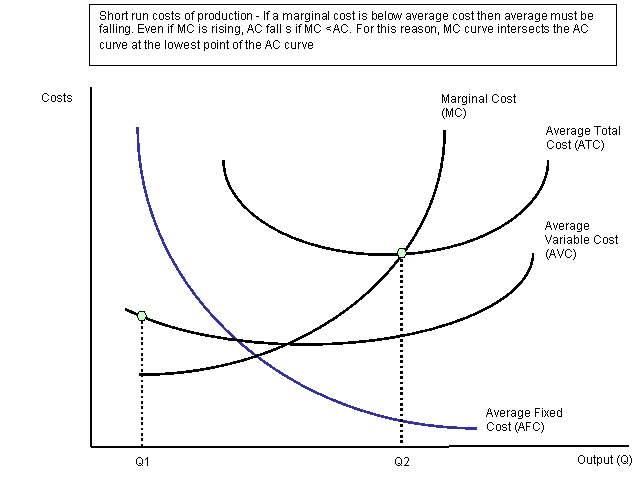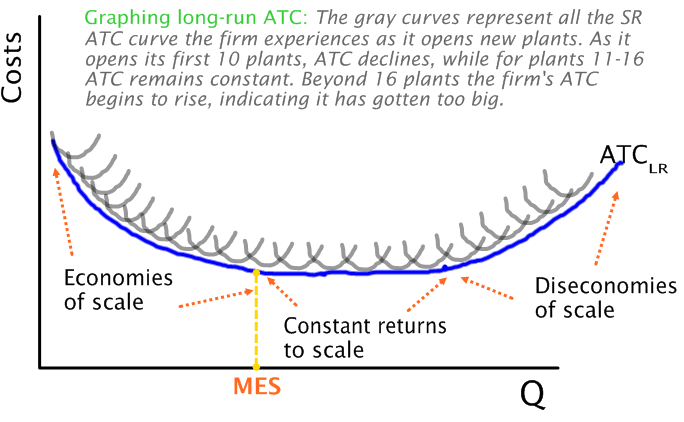
- •2. Intertemporal choice problem as foundation of the modern theory of finance.
- •3. Basic economic theory of risk. Expected utility function, risk premium and risk aversion measures.
- •4. Technology, profit maximization and theory of firm and industry supply
- •5. Production costs in short run vs long run and cost minimization problem.
- •Variable Costs
- •Isocost Lines
- •6. Types of industrial markets. The model of perfect competition.
- •7. The theory of monopoly. State regulation of monopoly markets.
- •8. (И.К.)Models of oligopoly and game theory applications
- •9. 9. Institutional foundations of economic systems. The economic theory of property rights.
- •10. Transaction costs: the origin, nature, classification, measurement problems.
- •11. Theory of information, properties, info asymmetry and methods of overcoming it
- •Information asymmetry
- •12. Gdp as an indicator of economic results of the macroeconomic system.
- •Income approach
- •13. Aggregate demand and aggregate supply. The ad-as model.
- •14. Consumption, savings and investment. “Keynesian Cross”.
- •15. Money market. The demand for money and supply, factors that determine them. Equilibrium in the money market.
- •16.Joint balance of real and monetary sectors of the economy (model is-lm).
- •17. Cycles of economic dynamics. Sources of cyclical fluctuations in economic conditions.
- •18. Inflation, its types and methods of measurement. Factors and consequences of inflation. Anti-inflationary policies.
- •19. Disequilibrium in the labor market. Unemployment and its types and methods of measurement.
- •20.Globalization and the polarization in the modern world economy.
- •21.General economic equilibrium in an open economy (model Mandell - Fleming).
- •Is components
- •22.(И.К.)Efficient Market Hypothesis (emh): Concept, Forms, Arguments for and against.
- •23. Economic Data and Econometric Analysis. Four types of Economic Data. Role of Econometrics. Main Application of Econometrics.
- •24. Financial Econometrics, it’s object. Type of equations in mathematical modeling: behavioral equations and identities.
- •25,26,27,29 Simple regression analysis. The Simple Linear Model. Least Squares Regression. Interpretation of a Regression Equation.
- •28.Ordinary Least Squares (ols). The Gauss – Markov Theorem.
- •30.Heteroscedasticity. Possible Causes of Heteroscedasticity. The Goldfeld–Quandt Test.
- •31.Autocorrelation. Possible Causes of Autocorrelation. The Durbin–Watson Test.
- •32.Multiple Regression Analysis. Derivation of the Multiple Regression Coefficients.
- •33.Properties of the Multiple Regression Coefficients: unbiasedness, efficiency, precision, consistency.
- •34.Multiple Regression Analysis. Problem of Multicollinearity.
- •35. Purchasing Power Parity Theory: Concept, Forms, Application
- •36. Fisher Effect Parity Theory: Concept, Application
- •37 International Fisher Effect Parity Theory: Concept, Application
- •38. Interest Rate Parity Theory: Concept, Application
- •39. The composition of the global financial market: instruments, participants, sources of information.
- •41. Types of banks and their role in the international financial market.
- •42. The global equities market: size, indicators, principles of organization.
- •43. The global debt securities market: composition, principles of organization.
- •44. The international debt securities: types and organization.
- •45. The government bond markets: size, composition, significance.
- •46. Mortgage-backed securities: mechanism of issuance, the role in the international financial crisis of 2007-2009.
- •47. Exchange-traded derivatives: types, functions, mechanism of trading.
- •48.Otc derivatives. Swaps.
- •49. Types of institutional investors and their role in the global financial markets.
- •50. The functions of the international financial organizations (imf, World Bank, bis).
- •International trade financing
- •52. International banking: the structure and operational function, the services offered, and measures to improve the efficiency and effectiveness of the international banking organization.
- •53. The major issues in International banking: international money laundering, international banking crisis, regulation of international banking, and offshore banking markets.
- •54. Acquisitions and Mergers in Financial Services Management.
- •55.Measuring and evaluating the performance of banks: financial ratio analysis, profitability analysis.
- •57. Bank Financial Management:
- •58.(И.Р.)Requirements for an effective audit and evaluation of evidence (Не полностью описал)
- •59. The audit process and audit report
- •60. Generally Accepted Auditing Standards and Code of Professional Conduct
- •Accounting principles;
- •Confidential client info not disclose without specific consent.
- •61. Cost concepts, classification, and allocation.
- •62. Job order costing system & cost flow
- •63. Process costing and equivalent production
- •65.(И.Р.)Cost behavior and cvp analysis
- •66. Accounting Cycle, Generally Accepted Accounting Principles, and Financial Statements
- •Accounting Cycle – Steps During the Accounting Period
- •Accounting Cycle: Steps at the end of the accounting period
- •67. Merchandising operations & inventories
- •Inventory Costing Methods
- •Perpetual fifo
- •Perpetual lifo
- •68. Internal control, cash and receivables
- •69. Current & long term Liab.
- •70.Long term Assets.
- •71. Contributed Capital & corporate statements.
- •72.(И.Р.)Cash flow statement
- •73. Accounting Rate of Return Method as an Investment Rule. Application and possible Problems
- •74. Payback Method as an Investment Rule. Application and possible Problems.
- •75. Internal Rate of Return Method as an Investment Rule. Application and possible Problems.
- •76. Profitability Index Method as an Investment Rule. Application and possible Problems.
- •1) The method requires an estimate of the cost of capital in order to calculate the profitability index
- •2) The method may not give the correct decision when used to compare mutually exclusive projects.
- •77. Net Present Value Method as an Investment Rule. Application and possible Problems.
- •78. Capital Structure Concept.
- •79. Dividend Policy
- •80. Arbitrage Pricing Theory (apt)
- •81. Capital Asset Pricing Model (capm)
- •82. Fama and French Three Factor Model of Assets Pricing
- •83. Duration concept, application, concept of convexity, and how convexity affects macalay’s duration
- •83. Duration concept, application, concept of convexity, and how convexity affects macalay’s duration
- •84. Valuation based on Price Multiples: p/e, p/bv, p/s.
- •85. (И.К.)Asset Based Valuation Model, Residual Income Valuation Model Asset-based valuation
- •86.(И.Р.)Dividend Discount Model
- •87. Discounted Cash Flow (dcf) Valuation Model
- •88. Capital Structure: Differences between Companies
- •89. Capital structure: Differences between Countries.
- •90. Exporting as a foreign market mode, merits, demerits
- •91. Collaborative Arrangements: Licensing, Franchising, Management Contracts
- •92. (И.К.)Risky assets and portfolio optimization problem.
- •Investors can use either a top-down or bottom-up approach:
- •95. Credit Risk Models
- •96. International Diversification: investing in different markets.
- •97. Translation exposure
- •98. Transaction Exposure.
- •99. Operational Exposure
- •100.(И.Р.)Foreign Direct Investments: Joint Ventures, wholly owned Subsidiaries
- •101. Securitization (s): creation of abSs, participants and functions, securitization’s impact and risks, regulators’ concerns.
- •103. Classification and comparative characteristics of derivatives.
- •1.By the relationship between the underlying asset and the derivative :
- •3.By the market in which they trade:
- •1.Call and Put options
- •2.Exchange-traded or Over-the-counter (otc) options
- •105. Swaps: concept, types, strategies for using
- •106. Futures: concept, types, strategies for using
5. Production costs in short run vs long run and cost minimization problem.
The short run is a period of time when there is at least one fixed factor of production i.e. some factor inputs that cannot be altered. This is usually fixed capital such as machinery and the amount of factory space available. Output increases when more units of variable factors (labour and raw materials) are added to fixed factors. Hence in the short run a firm will have fixed and variable costs of production. Total cost = fixed cost + variable cost.
Short Run Cost Curves:

A change in variable costs:
A rise in the variable costs of production leads to an upward shift both in marginal and average total cost. The firm is not able to supply as much output at the same price. The effect is that of an inward shift in the supply curve of a business in a competitive market.

The Long-run:
Period of time long enough for firms to change the quantities of all resources employed including capital and new factories. In the long run, there is no distinction between FC and VC because all resources (therefore costs) are variable in the long run. In the long run, an industry and the individual firms it comprises can undertake all desired resource adjustments or in other words, they can change the amount of all inputs used. The long run allows sufficient time for new firms to enter or for existing firms to leave an industry.
The long-run cost curve:
The
green, orange, yellow, pink, blue curves are separate short run
curves. The long run curve is created by combining all the lowest ATC
at any output of the short run curves.
Costs help determine the resource mix a firm will use, how much output a firm will produce, whether profit is realized, and whether a firm will continue to produce in the long run.
Production costs are broken down into two broad categories: fixed costs and variable costs. Total costs are the sum of all fixed and variable costs and can be expressed as:
TC = TFC + TVC
Fixed Costs
Fixed costs arise because some inputs are fixed in the short run. For example, plant size and capital are typically fixed in the short run, and payments for their use . monthly rent, property taxes, loan payments for capital, etc., . are costs a firm incurs regardless of the level of production: 1,000 units a day, 100 units a day, or 0 units a day.
Fixed costs are the sum of all short run costs that are unrelated to the level of output.
Managers often refer to fixed costs as overhead, indicating that these costs are unaffected by output.
Decision-making should not be influenced by fixed costs, such costs are sunk. For example, President Johnson was supposedly reluctant to bring an end to the Vietnam War in 1967 because he felt that doing so without achieving some sort of victory would mean that all the lives lost up to that point were lost in vain. Deciding whether or not to end a war, however, should not be based on sunk costs (lost lives), because sunk costs are irretrievable no matter what happens. Similarly, rational business decisions will not be determined by unrecoverable fixed costs.
Fixed costs are meaningful only to the extent that, like history or archeology, we can learn from them. Since they are fixed, there is a sense in which no alternative exists, so the opportunity costs of fixed resources are zero in the short run. Therefore, only opportunity costs should affect production decisions - costs that vary with output because alternatives are foregone while incurring these costs.
